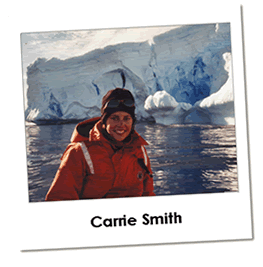
| Home > The Scientists > Carrie Smith | |||||||||||||||
Whilst studying at UTAS, Carrie also worked for Echo Projects on the bioremediation project of the old Tioxide site at Heybridge. The bioremediation system was designed to fully reduce very high concentrations of heavy metals using low cost technology. It stands as one of the most successful acid-leachate treatment systems in the world. The second phase of the treatment process is an oxidation wetland, which was designed to remove secondary contaminants and create a habitat for ecotourism use. “To be involved in such innovative environmental project with my qualifications at the time, age, experience (or lack of) and the opportunity to work alongside leading scientists was certainly an inspiring experience and one which encouraged and strengthened my pursuit of wanting to complete my science degree”. “It wasn’t
until I got to uni that I realised how diverse science is and there
were so many different areas of science that I hadn’t even
considered”. One of these areas was Antarctic Biology. “I
didn’t realise you could actually study Antarctic Biology
specifically”. So for her Honours project she combined both
the Antarctic and marine areas to investigate the influence of vegetation
and predation on Short-tailed Shearwaters and Little Penguins on
Wedge Island in south-east Tasmania. Carrie designed and implemented
a sampling method to obtain an estimate of these seabird populations
on the island, involving aerial photographs, digital data, GPS equipment
and habitat measurements. “I love being out in the field,
collecting real data”. The diet of resident feral cat predators
and their influence on population dynamics of the seabird species
were also investigated.
“Having a science degree gave me the opportunity to see a part of the world that few people get to see and I feel very privileged to have been given that opportunity. The project also allowed me to do the kind of work I really enjoy – hands-on science”. On return from Antarctica, Carrie was regularly asked to give talks and presentations on her experience. Her new found interest in public speaking led her to her current position at the Imaginarium Science Centre in Devonport. Here, Carrie writes and performs science shows, organises school visits, activities and holiday programs as well as maintaining the day-to-day administration of the centre. This position has given Carrie a new found interest into science communication. “I really enjoy getting young people excited and enthusiastic about science”. Carrie recently received an ASTEN (Australasian Science and Technology Exhibitors Network) Fellowship that will allow her to spend a week of professional development at the Scitech Discover Centre in Perth, WA. “I’ve found that having a scientific background is not as limiting as some people may feel, but rather opens doors of opportunity where companies look for the skills you have obtained while studying for your degree, rather than just the facts and figures that you can remember. My job as a science communicator is just one of many that are available to people with a scientific background. Science is so diverse. It’s certainly not the lab coat, crazy hair and glasses image that some people may perceive. There are many opportunities out there for science graduates and what I have achieved so far is just a small drop in the ocean compared to what else there is out there”.
Find out more about Carrie's Project Key words: Seabirds, Penguins, Albatrosses, Shearwaters. Accurate understanding of seabird distribution and abundance is important because it provides valuable information about the extent of fluctuations in marine ecosystems, trends in population sizes, use of foraging areas and to ensure appropriate conservation and management measures are implemented. Tasmania is a stronghold both nationally and globally for many seabird species; however, some population estimates are vague and there is little information on their distribution and the extent of colonies around Tasmania, making the assessment of population trends difficult. For her Honours project on Wedge Island, Carrie’s aims were to:
East-west transects were established across the entire island and a circular quadrat was located at regular intervals along each transect. Quadrats were located using a hand-held GPS in latitude and longitude coordinates and imported into a mapping program. During the breeding season 7 surveys were made between December 2002 and April 2003. During each survey the number of occupied and unoccupied burrows were recorded, using a burrow camera in each quadrat. Total population was then estimated as the product of mean density of birds on the island and total area of the island. Useful Websites: For more information and great ideas for classroom activities, visit:
Classroom Activities:
|
|||||||||||||||


